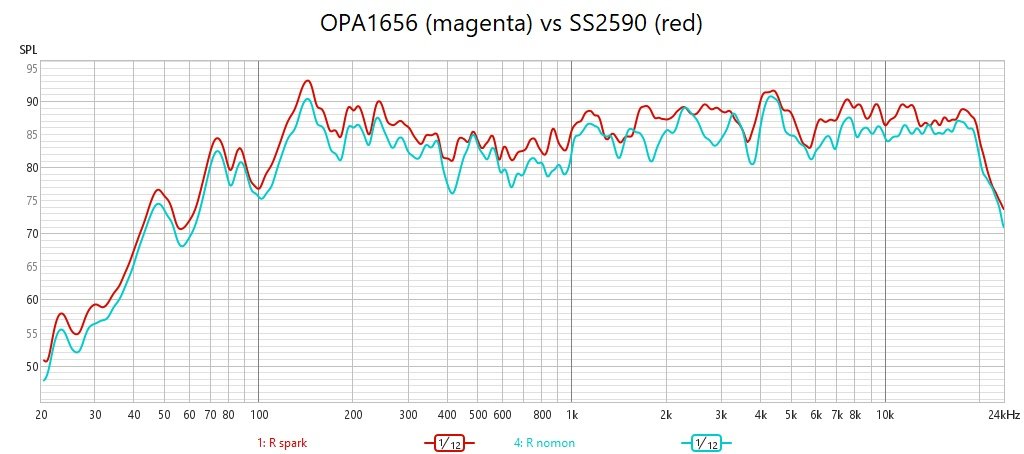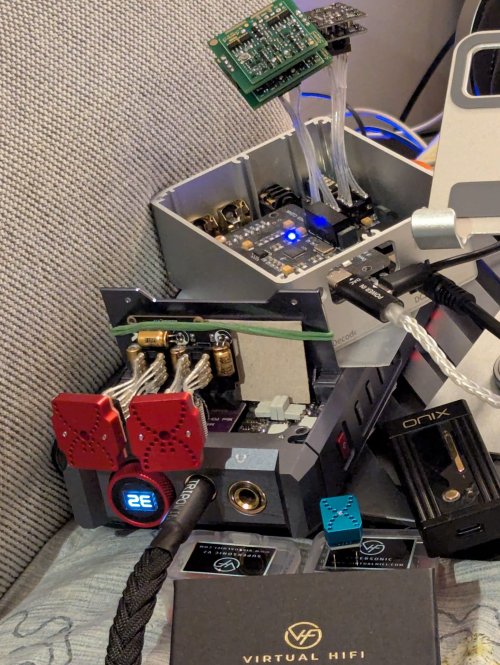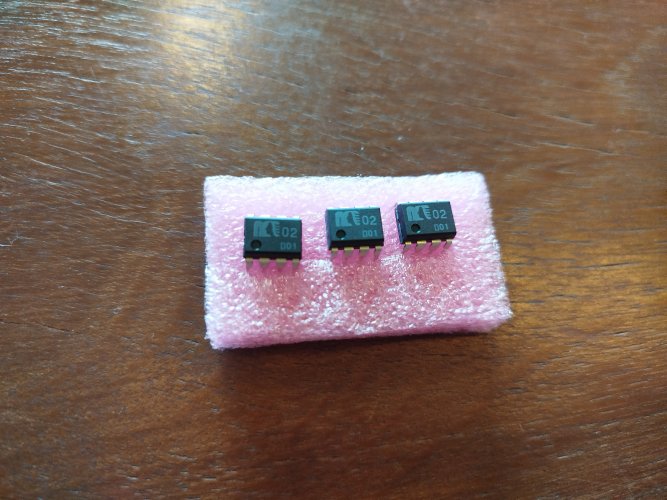Burson V5i
First impressions without burnin in I/V in Xonar.
Full, smooth, liquid.
The original V5 SS was exceedingly detailed and sharp before burn in. This seems much mellower and softer.
(Das Grosse Erwachen – Annett Louisan) instruments not clearly distinguished. Voice right between ears and is lovely.
(Rehab – Amy Winehouse) muddled mess. Hard to distinguish instruments.
(L’Amor – Arianna Savall) Soft and gentle, missing micro detail. Veiled.
Makes me want to turn up the volume to catch that micro detail that I am used to. I can feel that much is missing. Muffled like when there is a haze vs a crisp cool day where you can see for miles.
The blackness of the V5 SS is ethereal and weightless. The V5i blackness is heavier, smaller.
Before burn in. Polite, no sibilance, good bass. Gets confused with many instruments of similar timbre.
Decay is not good. Bass quantity is good but wooly, indistinct.
Ok, after a little burn in:
Treble is finally coming up. Separation is becoming better. There is something not quite right in the mids. I feel like I’m straining to hear the pristine detail from the V5 SS.
Listening to Annett Louisan – Zu viel Information, there are sleigh bells or a tambourine but they sound like a bag of nuts right now.
I hope this is only burn in. Will let it burn more… more!!!
After sufficient burn in:
These are actually really good. The treble is clear, fast and detailed. The bass is full and thick. They are obviously better than average chip opamps. More dynamic, smoother and more detailed.
If you are wondering what to upgrade your JRC 2114 or 49720 or even the AD 797 and LME 49990 with and cost is a consideration, then go for the V5i. These are hands down better than those chips.
If price does not matter or you already have the big boy V5 SS then these are not for you.
Now, onto a problem that I have with the V5i.
My favorite headphone amp is a variation of “The Wire”. Signal comes in and goes straight to the I/V stage. The output goes straight into an LME 49600 buffer and goes straight to the headphones. No resistors or capacitors in the signal path with one caveat. I have a switch to enable or bypass input capacitors, depending what source I am using. If the source has any offset I use the caps, If no offset then no caps. DC coupled perfection. To my ears this sounds better than a circuit with a servo. Perhaps I am not good enough at implementing a good servo, but I swear a servo does not sound as clean or dynamic as a circuit without it.
So here is my first problem. The V5 SS give me 0.01 mv offset. The V5i produces a whopping 100mv for the two single V5i on an adapter and around 70 mv on a dual V5i. That is unacceptably high in my headphone amp. I have tried taming it with different resistor settings but based on the info in the data sheet, I don’t have the magic formula. (If anyone here can figure out the resistor settings, let me know and I’ll try them)
So anyone who does not have output capacitors or a servo needs to check their offset before hooking up headphones if you have a V5i in your headphone amp.
I understand that my particular amp is the most sensitive to this problem but I have not run into this kind of offset with any other opamp except the NE5534.
The norm for a chip opamp in my setup is around 3 mw. The V5SS is really phenomenal in this respect.
For me the V5 SS is the mike drop of all op amps. Since I put those in, there has not been one twitch towards the other opamps. I didn’t even think about them. Why would I want to pull out the V5 for any of those little chips?
V5i has me thinking about how to fix it again. I added the Silmic II caps and of course they helped but… once you are spoiled, then what?
Another small (non) issue is the lip on the metal cap. If you want to use two singles on an adapter, these will pose a problem. I ended up sanding the lip off so I could squeeze them together. However, there really is no reason to use two singles on an adapter. The dual already is two singles. No benefit to be had.
Anyone considering the V5i needs to be aware that burn in on these is painful. It is the opposite of the V5 SS. The V5 SS starts off as sharp, the trebles are piercing and need time to mellow. The V5i starts off as dull and this is really frustrating. It is a muddy, bass heavy mess until it burns in. Once you are there, the instrument placement is correct and the bass is clean. Give these at least 100 hours before listening critically. Otherwise you will just pull them out.
My conclusion: For their price range they are the best opamps. But if you spent any time with the V5 SS it will be very hard to live with the V5i. If you are moving up the opamp ladder, this is a significant improvement over the usual chip opamps. If space does not allow for V5 SS then (aside from Sparkos which I want to try out) the V5i will be your best bet.




























